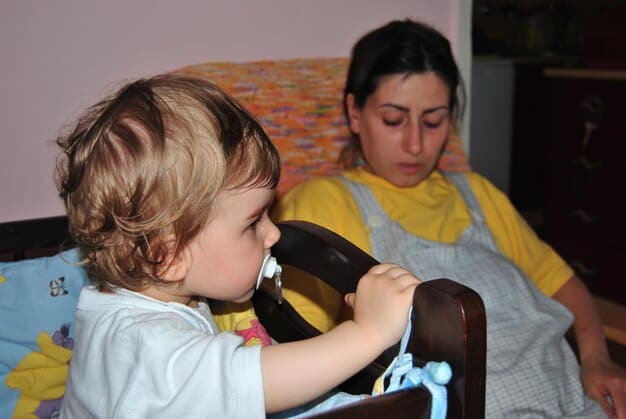Attachment Styles: Impact on Child Development & Behavior

Understanding Attachment Styles: How Early Relationships Shape Child Development and Behavior explores the profound influence of initial caregiver interactions on a child’s psychological and social landscape, profoundly affecting their emotional regulation, interpersonal skills, and overall well-being throughout life.
The journey of every individual begins with early relationships, profoundly influencing their foundational understanding of the world and their place within it. Exploring Understanding Attachment Styles: How Early Relationships Shape Child Development and Behavior reveals the critical role these initial bonds play in shaping a child’s emotional, social, and cognitive trajectory, laying the groundwork for future interactions and self-perception.
the origins of attachment theory: early insights
Understanding attachment styles begins with appreciating the foundational work that brought this concept to the forefront of developmental psychology. John Bowlby, a British psychoanalyst, pioneered attachment theory in the mid-20th century, seeking to understand the distress experienced by infants separated from their primary caregivers. His work challenged prevailing psychological views that focused solely on basic needs like food, arguing instead that infants possess an innate psychobiological system that motivates them to seek proximity to significant others for protection and comfort. This drive for connection, Bowlby posited, is a primary human need, not merely a secondary one derived from feeding. He observed that children form a strong emotional bond to caregivers, a bond crucial for their survival and well-being.
Bowlby’s colleague, Mary Ainsworth, further expanded on his theoretical framework through empirical research, most notably with her “Strange Situation” experiment. This innovative procedure allowed researchers to observe parent-child interactions under controlled stressful conditions, specifically when the primary caregiver left and returned. Through meticulous observation and classification of infant behaviors, Ainsworth identified distinct patterns of attachment, which she categorized into various styles. Her findings provided critical empirical evidence supporting Bowlby’s theory, distinguishing between secure and insecure attachment patterns and highlighting the profound impact of caregiver responsiveness on an infant’s developing sense of security.
The concept of an “internal working model” is central to attachment theory. Bowlby suggested that through repeated interactions with caregivers, children develop unconscious mental representations of themselves in relation to others, and of the world as a predictable or unpredictable place. These internal working models are essentially cognitive and affective schemata derived from attachment experiences. If caregivers are consistently available and responsive, a child develops a positive internal working model, seeing themselves as worthy of love and others as trustworthy. Conversely, inconsistent or neglectful care can lead to negative internal working models, fostering feelings of unworthiness or distrust. These models, once formed, tend to be stable over time, influencing an individual’s expectations and behaviors in future relationships, acting as a template for navigating social interactions well into adulthood. This ongoing influence underscores the long-term significance of early attachment experiences.
The development of attachment is a dynamic process, not a static event. It emerges from a long series of interactions between the infant and the caregiver. The quality of these interactions, particularly the caregiver’s sensitivity and responsiveness to the infant’s cues, is paramount. When a caregiver is attuned to an infant’s signals of distress or need and responds appropriately and consistently, a secure attachment is more likely to develop. This responsiveness helps the infant learn that their needs will be met, fostering a sense of trust and security. Conversely, inconsistent or rejecting responses can lead to insecure attachment patterns, where the infant learns that their needs may not always be met, leading to anxiety or avoidance in their relational strategies. Over time, these repeated patterns of interaction solidify into an attachment style that the child carries forward.
the four attachment styles and their characteristics
secure attachment: the foundation of healthy development
At the core of healthy child development lies secure attachment. Children who are securely attached typically have caregivers who are consistently responsive, sensitive, and nurturing. These children feel safe and confident exploring their environment, knowing that their caregiver is a secure base to return to when distressed. They exhibit a balance of independence and reliance, comfortably seeking comfort when needed but also engaging with their surroundings. When reunited with their caregiver after a brief separation, they are easily soothed and quickly return to play.
* Comfortable exploring: Securely attached children use their caregiver as a secure base, venturing out to explore new surroundings knowing they can return for reassurance.
* Effective emotional regulation: They learn to manage their emotions better, thanks to caregivers who validate their feelings and teach them coping mechanisms.
* Positive self-perception: They develop a belief in their own worthiness and the reliability of others, leading to higher self-esteem.
This attachment style fosters a robust internal working model where the child perceives themselves as lovable and valuable, and others as trustworthy and available. This positive foundation supports strong social skills, emotional resilience, and a greater capacity for empathy in later life.
anxious-preoccupied attachment: seeking constant reassurance
Children with an anxious-preoccupied attachment often have caregivers who are inconsistently responsive—sometimes attentive, sometimes dismissive. This unpredictability leaves the child feeling uncertain about the caregiver’s availability. As a result, they tend to be overly clingy, seeking constant reassurance and attention. They may become highly distressed upon separation and remain difficult to soothe upon reunion, displaying a mix of relief and resentment towards the caregiver.
Their internal working model is characterized by self-doubt and a high need for external validation. They may view themselves as unworthy but urgently in need of love, while perceiving others as potentially abandoning. This can lead to exaggerated emotional responses and a constant struggle for proximity and approval, often at the expense of independent exploration or self-soothing. These early experiences can manifest in adult relationships as a fear of abandonment, excessive jealousy, or a strong desire for fusion with a partner.
avoidant-dismissive attachment: suppressing emotional needs
In cases of avoidant-dismissive attachment, children often experience caregivers who are consistently rejective or unresponsive to their emotional needs. These children learn early on that expressing distress or seeking comfort is ineffective or even met with disapproval. Consequently, they suppress their emotional expressions and appear remarkably independent. They may avoid their caregiver upon reunion after separation and show little overt distress.
Their internal working model suggests that relying on others is futile and that emotions are something to be repressed. They value self-sufficiency to an extreme, often struggling with intimacy and emotional vulnerability. In adulthood, this can translate into difficulty forming deep connections, a tendency to distance themselves when relationships become too close, and a discomfort with emotional displays in themselves and others. The perceived strength of their independence often masks an underlying difficulty with emotional connection and a powerful desire to avoid rejection.
disorganized-fearful attachment: confusion and inconsistency
The most complex and often challenging attachment style is disorganized-fearful attachment. This style typically emerges from unpredictable and often frightening caregiving experiences, such as abuse, neglect, or caregivers who are themselves frightened or frightening. The child is caught in a profound conflict: the caregiver is both the source of comfort and the source of fear. This paradox leads to confused and contradictory behaviors. Upon reunion, they may approach the caregiver then suddenly turn away, or show dazed, frozen, or fearful expressions.
* Contradictory behaviors: Children might approach their caregiver for comfort but then abruptly retreat, demonstrating a lack of a coherent strategy for seeking safety.
* Difficulty with emotional regulation: They often struggle with intense emotions and exhibit erratic responses, unable to predict caregiver reactions.
* Impact on self-concept: This uncertainty can lead to a fragmented sense of self and profound difficulties in forming stable relationships, as trust is constantly undermined by fear.
The child’s internal working model is fragmented and chaotic, reflecting the unpredictable nature of their early environment. They may long for closeness but simultaneously fear it, leading to volatile and unstable relationships in adulthood. This style is often associated with later difficulties in emotional regulation, interpersonal relationships, and increased risk for psychological disorders. Understanding these distinct patterns helps shed light on the pervasive influence of early relational experiences on long-term development.
the subtle dance: caregiver sensitivity and responsiveness
The development of healthy attachment styles hinges significantly on the twin pillars of caregiver sensitivity and responsiveness. These aren’t abstract concepts but rather tangible behaviors that profoundly shape a child’s internal world. Caregiver sensitivity refers to the ability to accurately perceive and interpret an infant’s signals and communications. This means not just reacting to a cry, but understanding *why* the child is crying – whether it’s hunger, discomfort, or a need for connection. It’s about being attuned to their non-verbal cues, their gazes, their movements, and their vocalizations. When a caregiver consistently demonstrates this attunement, they effectively communicate to the child that their needs are seen and understood.
Responsiveness, on the other hand, is the prompt and appropriate reaction to those perceived signals. It’s not enough to simply understand; one must also act in a way that meets the child’s needs effectively. For example, if a child is distressed, a responsive caregiver offers comfort, whether through a soothing touch, a calming voice, or by addressing the source of the distress. This timely and context-appropriate response helps the child learn that their world is predictable and that they can rely on their caregiver to provide safety and solace. This interplay between sensitive perception and responsive action builds a cycle of trust and security.
When caregivers consistently offer this sensitive and responsive care, they lay the groundwork for a secure attachment. The predictable and comforting nature of these interactions allows the child to develop a sense of self-efficacy – knowing that their signals will elicit a comforting response – and a positive view of others as reliable and nurturing. This reciprocal dance between caregiver and child fosters emotional regulation skills in the child, as they learn that even intense emotions can be managed with the help of a trusted adult. They internalize a feeling of being valued and competent, which serves as a protective factor against future stressors.
Conversely, a lack of sensitivity or consistency in caregiving can lead to insecure attachment patterns. If a caregiver is often dismissive of a child’s cries, or responds inconsistently (sometimes with warmth, other times with impatience), the child learns that their needs are not reliably met. This unpredictable environment can lead to confusion, anxiety, or a tendency to suppress emotional expression. Such children may develop coping mechanisms that, while functional in their immediate environment, can hinder their long-term emotional and relational development, demonstrating the critical and continuous impact of early caregiver interactions on a child’s psychological blueprint.

the long shadow: how attachment styles unfold in childhood
The attachment patterns formed in infancy don’t simply disappear as a child grows; rather, they continue to exert a profound and often subtle influence on their development throughout childhood. These early relational templates shape how children perceive themselves, how they interact with peers and teachers, and how they navigate emotional challenges. For children with a secure attachment style, childhood typically unfolds with a greater sense of confidence and resilience. They are more likely to engage in cooperative play, form positive friendships, and approach new situations with curiosity rather than fear. Their internalized sense of security allows them to explore the world as a safe place, knowing they have a reliable base to return to when needed. This confidence extends to their learning environments, where they are often more engaged and less anxious about making mistakes.
Children with insecure attachment styles, however, face different developmental trajectories. Those with an anxious-preoccupied attachment may exhibit heightened anxiety in social situations and clingy behavior with teachers or other adults. They might struggle with separation from parents, even as they get older, and may seek excessive attention or validation from peers. Their internal working models, which suggest a need for constant reassurance, can make them highly sensitive to perceived rejection and prone to emotional outbursts when their needs for attention are not met. This can sometimes lead to difficulties in forming stable peer relationships, as their intense need for connection can overwhelm others. They might experience friendship as a constant test, leading to cycles of seeking closeness and then feeling let down.
For children with an avoidant-dismissive attachment, their childhood may be characterized by an outward appearance of self-reliance, which often masks an underlying discomfort with emotional intimacy. They might seem withdrawn from group activities, prefer solitary play, and be hesitant to seek help from adults, even when they genuinely need it. Their emotional expressions may be muted, and they can struggle to understand or empathize with the feelings of others. This emotional distance can make it challenging for them to form deep, reciprocal friendships, as they tend to keep others at arm’s length. Teachers might describe them as independent, but an astute observer might notice their difficulty in expressing vulnerability or seeking comfort. They might internalize problems, rather than seeking support from others, which can have long-term implications for their mental health.
Finally, children with a disorganized-fearful attachment often display the most inconsistent and unpredictable behaviors. Their internal conflict, stemming from a caregiver who is both a source of comfort and fear, manifests in confused and sometimes contradictory actions. They might approach a peer with curiosity but then suddenly withdraw, or show bursts of anger followed by withdrawal. These children often struggle significantly with emotional regulation, oscillate between seeking and avoiding closeness, and may have difficulty forming a coherent sense of self. Their relationships with peers and adults can be chaotic and unstable, reflecting the lack of a clear internal working model for navigating relationships. They may also be at higher risk for behavioral problems, anxiety, and depression, underscoring the vital need for intervention and consistent, supportive relationships to help them build more secure attachments. The subtle but profound ways these early patterns shape childhood experiences underscore the enduring legacy of early relational bonds.
attachment and the developing brain: a neurological perspective
The science behind attachment styles isn’t solely confined to psychological theories; it extends deeply into the very architecture of the developing brain. Early attachment experiences, particularly the consistency and quality of caregiver responses, play a crucial role in shaping a child’s neural pathways, especially those related to emotional regulation, stress response, and social cognition. From a neurological perspective, infancy and early childhood are periods of immense brain plasticity, where experiences literally sculpt the brain’s structure and function. Secure attachment, characterized by consistent sensitive care, promotes the healthy development of key brain regions.
For instance, the prefrontal cortex, which is vital for executive functions like planning, decision-making, and emotional regulation, is profoundly influenced by early relational experiences. When an infant experiences predictable and soothing responses to distress, the developing neural circuits learn to effectively regulate stress. The amygdala, often referred to as the brain’s “alarm system,” becomes less hypersensitive, and the hippocampus, crucial for memory and learning, develops optimally. This secure base allows the child’s brain to allocate resources to learning and exploration rather than being constantly on high alert, fostering cognitive growth and emotional stability.
Conversely, insecure attachment styles are often linked to altered brain development. Children experiencing inconsistent or neglectful care may develop an overactive stress response system, primarily involving the hypothalamic-pituitary-adrenal (HPA) axis. Chronic activation of this system due to perceived threat can lead to elevated levels of cortisol, a stress hormone, which can be neurotoxic over prolonged periods. This can impair the development of the prefrontal cortex and hippocampus, making it harder for these children to regulate emotions, learn effectively, and manage stress later in life. They might become easily overwhelmed, exhibit heightened vigilance to threat, or struggle with memory and attention due to the constant internal “noise” of an unregulated stress response.
Moreover, the development of the social brain — the network of regions involved in understanding and interacting with others — is heavily influenced by attachment experiences. The orbitofrontal cortex, which plays a role in social decision-making and empathy, and the insula, involved in processing emotions and interoception (awareness of internal bodily states), are particularly responsive to relational input. Secure attachment promotes the integration of these social brain regions, leading to a greater capacity for empathy, better social communication, and more attuned social interactions. In contrast, insecure attachment can lead to less flexible and adaptive social behaviors, manifesting as difficulties in reading social cues, limited emotional range, or challenges in reciprocal relationships. The profound neural imprint of early attachment experiences underscores why these foundational bonds have such an enduring impact on a child’s overall development and well-being.
repairing ruptures: fostering secure attachment later in life
While early attachment experiences lay a significant groundwork, the concept of attachment is not deterministic. The human capacity for change and growth means that attachment styles can evolve and be “earned” secure through corrective emotional experiences, even later in life. This process, often referred to as “earned security,” involves consciously or unconsciously processing past experiences and developing a more coherent narrative about one’s relationships, leading to a shift in internal working models. Therapeutic interventions, supportive relationships, and reflective practices can all contribute to this transformative journey.
One of the most effective ways to foster secure attachment later in life is through consistent, positive, and corrective relational experiences. This can occur in various forms:
* Therapeutic Relationships: A skilled therapist can provide a secure base within the therapeutic relationship, offering consistent empathy, validation, and a safe space to explore past relational wounds. This corrective experience can help individuals process unresolved trauma and develop new coping mechanisms.
* Supportive Friendships and Partnerships: Forming healthy, secure relationships with friends, partners, or mentors who are reliably responsive and emotionally available can gradually reshape an individual’s internal working models. These relationships provide concrete evidence that trustworthy and empathetic connections are possible.
* Parenting with Awareness: For parents who had insecure attachments themselves, consciously striving to provide secure attachment for their own children can be a powerful therapeutic experience. By actively practicing sensitive and responsive parenting, they not only foster security in their children but also reinforce a healthier attachment pattern within themselves.
Understanding one’s own attachment style is the first step in this transformative process. Through self-reflection, journaling, or guided therapy, individuals can gain insight into how their past relational patterns influence their current behaviors and expectations. This awareness allows for conscious choices to break maladaptive cycles. For instance, someone with an anxious-preoccupied style might learn to manage their fear of abandonment, while an avoidant-dismissive individual might practice allowing themselves to be vulnerable. This journey of self-discovery and intentional change highlights the remarkable resilience of the human spirit and the potential for profound personal growth beyond early developmental influences. Repairing relational ruptures is a continuous effort, but one with immensely rewarding long-term benefits for emotional well-being and relational fulfillment.

educational and societal implications of attachment theory
The insights gleaned from attachment theory extend far beyond individual psychology, profoundly impacting educational practices, policymaking, and societal approaches to child welfare. In educational settings, recognizing the influence of attachment styles can transform teacher-student interactions and classroom dynamics. Teachers can become crucial secondary attachment figures for children, particularly those from insecure backgrounds, by providing consistent emotional support, predictability, and a safe learning environment.
Educational implications include:
* Trauma-Informed Practices: Schools are increasingly adopting trauma-informed approaches, which recognize that students’ behaviors are often a result of their past experiences, including early relational challenges. This leads to more empathetic and supportive responses to difficult behaviors.
* Building Secure Relationships: Teachers trained in attachment theory understand the importance of forming strong, positive relationships with students. This involves active listening, validating emotions, and offering consistent reassurance, which can significantly improve a child’s engagement and academic performance.
* Early Intervention Programs: Identifying children with insecure attachment patterns early allows for targeted interventions, such as play therapy, small group work, or counseling services, to help them develop more secure relational strategies and emotional regulation skills before challenges escalate.
From a societal perspective, understanding attachment theory informs crucial public health and policy initiatives. Programs supporting new parents, promoting positive parenting skills, and providing resources for at-risk families are direct applications of attachment research. These initiatives aim to strengthen primary caregiver-child bonds, thereby preventing the long-term negative consequences associated with insecure attachment. Furthermore, child welfare systems benefit from an attachment lens, prioritizing permanency and stable caregiving arrangements for children in foster care to mitigate the effects of early relational disruptions.
Policy implications extend to:
* Parental Leave Policies: Extended and paid parental leave allows parents more time to bond with their infants, fostering early secure attachment.
* Early Childhood Education: High-quality early childhood programs that emphasize responsive caregiving and low child-to-adult ratios can support healthy attachment development outside the home.
* Mental Health Services: Increased access to mental health services for parents and children, focusing on relational challenges, can address attachment difficulties before they become deeply entrenched.
Ultimately, integrating attachment theory into educational and societal frameworks promotes a more compassionate and effective approach to nurturing the next generation. By recognizing the profound and lasting impact of early relationships, societies can invest in initiatives that not only support individual well-being but also foster a more emotionally resilient and connected populace. This paradigm shift underscores the collective responsibility to create environments that prioritize secure attachment as a cornerstone of healthy human development.
| Key Concept | Brief Description |
|---|---|
| 🤝 Secure Attachment | Child feels safe and confident, knowing caregiver is reliably available for comfort. |
| 😟 Anxious-Preoccupied | Child is uncertain of caregiver’s availability, seeks constant reassurance. |
| 🚶 Avoidant-Dismissive | Child suppresses emotional needs, appears overly independent due to unresponsive care. |
| 🌀 Disorganized-Fearful | Child exhibits confused, contradictory behaviors due to frightening or unpredictable care. |
Frequently Asked Questions About Attachment Styles & Child Development
Attachment theory states that infants form a strong emotional bond with their primary caregivers, which is crucial for their survival and development. This bond, or “attachment,” provides a secure base from which children can explore the world and return to for comfort and safety. Its quality profoundly impacts later psychological and social development.
Yes, while early experiences form a foundation, attachment styles can change. This process, often called “earned security,” involves having new, consistent, and positive relational experiences, often through therapy or healthy relationships, that help individuals re-evaluate their internal working models and develop more secure ways of relating to others.
A caregiver’s consistent sensitivity and responsiveness to an infant’s cues are vital. When needs are promptly and appropriately met, infants learn that their caregiver is reliable and that the world is a safe place, fostering secure attachment. Inconsistent or dismissive responses can lead to insecure attachment patterns, affecting trust and emotional regulation.
Insecure attachment can manifest in various ways throughout life. It may lead to difficulties in forming stable relationships, struggles with emotional regulation, lower self-esteem, and increased vulnerability to stress or anxiety. However, these effects are not deterministic; intervention and supportive relationships can mitigate them.
Schools can support children with insecure attachment by providing consistent, predictable, and emotionally supportive environments. Implementing trauma-informed practices, fostering strong teacher-student relationships, and offering early intervention services can help these children feel safer, regulate emotions, and improve their social and academic engagement.
Conclusion
The intricate dance of early human relationships shapes the very fabric of a child’s being, leaving an indelible imprint through the formation of attachment styles. From the pioneering insights of Bowlby and Ainsworth to the intricate neurological underpinnings of brain development, it becomes clear that understanding attachment is paramount to comprehending human psychology and social behavior. While the shadows of early insecure attachments can extend into adulthood, the human capacity for resilience and repair offers a beacon of hope. Through conscious effort, therapeutic support, and the cultivation of healthy relationships, individuals can navigate these templates and forge more secure paths. Embracing the profound implications of attachment theory, in both individual lives and broader societal structures, empowers us to cultivate environments that nurture secure bonds, fostering a generation better equipped for emotional well-being and meaningful connection.





